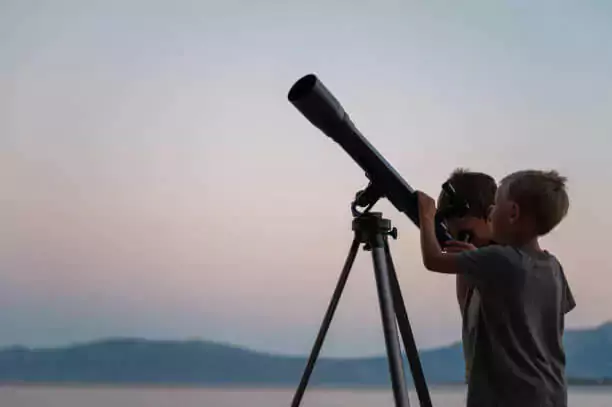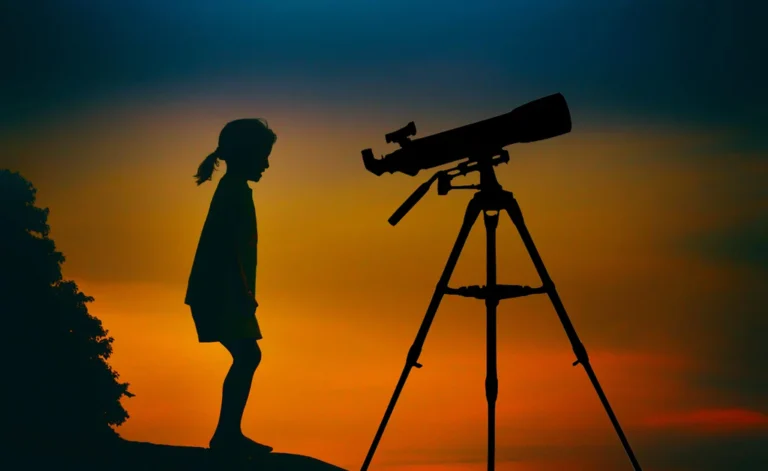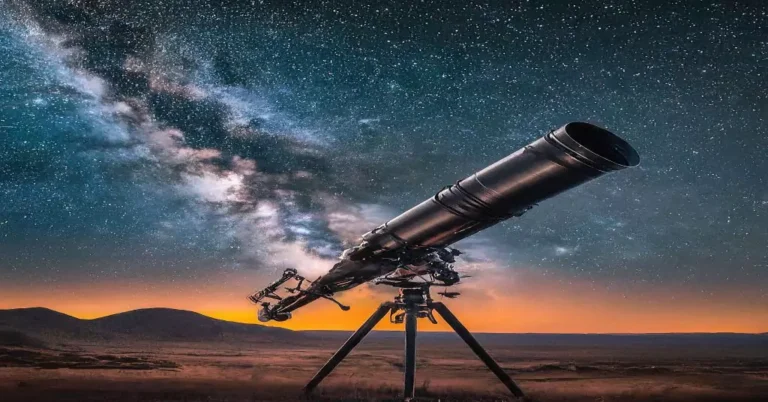Top 2026 Best Telescope Picks for Deep Space Observation
Do you dream of exploring the wonders of space beyond your imagination? Well, you’re in luck! To do so, you’ll need a powerful telescope because regular ones won’t cut it. These powerful telescopes have a large aperture that can bend light and reveal the hidden beauty of deep space. They can illuminate objects too dim to see with a basic telescope, making them perfect for exploring deep-space objects.
These specialized telescopes have fantastic features that allow you to observe objects beyond your wildest dreams, such as galaxies, clusters, and stardust. You can choose a telescope that fits your budget and has the desired features. Some telescopes come with motorized mounts and comprised control, which is more expensive. Our blog post will assist you in choosing the perfect telescope for your needs, regardless of whether you’re a beginner or an advanced astronomer. Our experts and reviewers have tested many telescopes and come up with a list of the best available options.
When selecting a telescope, you should consider aperture size, which is crucial when observing the deep sky. The larger the aperture, the more light it can collect, allowing you to see fainter objects. However, buying the most giant telescope you can afford isn’t always the best option. Other crucial factors are to consider when trying to catch those faint fuzzies. We’ll guide you through everything you need to know to make the best decision.
Understanding Deep Space Observation
Deep-sky objects mean that celestial objects exist outside our solar system; there are three main types of deep-sky celestial objects: nebulae, Star clusters, and galaxies. Nebula is a Latin word that means “Cloud.” A nebula (plural=nebulae) is a space cloud of gas and dust. Three types of nebulae have existed in deep space: bright, dark, and planetary. Glowing nebulae are a place of star formation. When stars begin to form, the place becomes too hot, and star radiation excites the nebula’s gas, causing it to shine. When you observe nebulae, you are witnessing the process of star formation. That is possible through a
Top Features of Telescopes for Deep Space Observation
There are top features that are very important in deep-space observation
Aperture size
As discussed above, the aperture size always matters (size always matters). A large aperture gathers much light, allowing you to observe faint objects from deep space. The aperture of the telescope is like a window in deep space.
Mount type
Stability plays a vital role in observation. A stable mount is essential for astrophotography and smooth tracking of distant celestial objects in the deep sky. Astrophotographers prefer Mount to mimic the earth’s rotation to manage the long exposure. However, deep-space observation altazimuth mount is also a viable option.
High-Quality optics
The clarity of the image depends upon the mirror and lens. So, the mirror and lens quality is crucial to producing clear images in the telescope. Select a telescope with multi-coated lenses and a mirror. Which reduces chromatic aberration and increases light transmission
Top 7 Affordable telescopes for profound space observation
Celestron NexStar 8SE
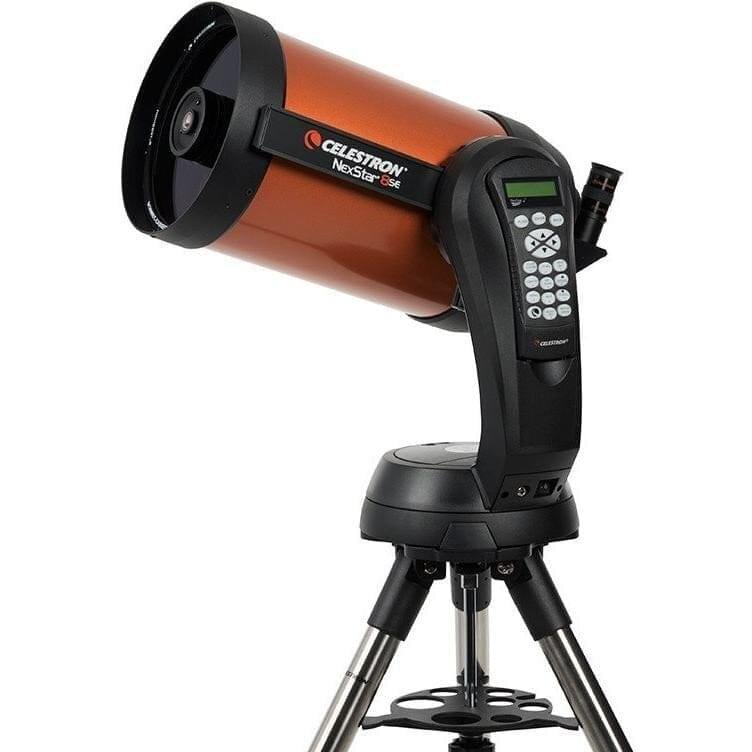
A best seller from Celestron and a top option for astrophotographers
Specs
| Optical design | Schmidt-Cassegrain |
| Mount type | Computerized Altitude-Azimuth Single Fork Arm |
| Aperture | 8-inch (203mm) |
| Focal length | 2032mm |
| Focal ratio | f/10 |
| Eyepieces included | 25mm |
| Highest practical magnification | 180x |
| Weight | 32 lbs (14.5kg) |
Pros
- Sharpness across the entire field of view
- Good value for money
- Highly portable
Cons
- Expensive outlay
- There is a little lag when slewing
- Power hungry, mains power recommended
There is no doubt Celestron NexStar 8SE is at the top of the list as it is superb optics. During our review, our expert was able to get sharp images of the surface of the moon. It is further capable of catching objects at a distance. It comes with a motorized mount. And after pressing the button, it moves very smoothly. That makes the ideal choice for an astrophotographer.
Celestron NexStar 8SE is very easy and convenient to set up and down, making it a good option for beginner astronomers. With the Celestron Align technology, it can be aligned with minimal prior knowledge. Once connected, the automatic mount can track the object you want to observe, making it very user-friendly.
Celestron NexStar 8SE required 8 AA batteries. So, you need to buy rechargeable or connect these power-hungry beasts to the main. That is the small downtown; otherwise, it is an excellent telescope and beginner-friendly
Unistellar eVscope 2
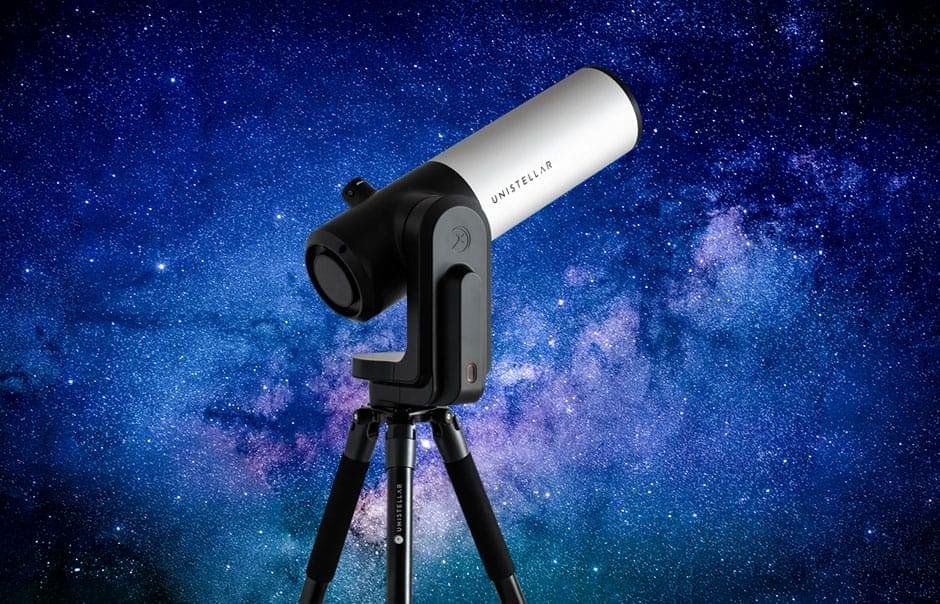
A powerful all-in-one system for tech lovers if you have a higher budget
Specs
| Optical design | Reflector |
| Mount type | Alt-azimuth |
| Aperture | 4.5-inch (114mm) |
| Focal length | 450mm |
| Focal ratio | f/3.9 |
| Effective magnification | 50x optical, 150x digital |
| Weight | 19.8 lbs (9kg) |
Pros
- Effortlessly simple setup
- The sleek design is stunning
- The app is well-designed and intuitive
Cons
- Extremely pricey, especially for new astronomers
- It may not appeal to purist telescope users
If you are a beginner and care about looking, it is the best telescope for profound space observation. And if you are on a budget or a purist and want some advanced feature, you may skip this because it is not your type (as she was not your type). It is a telescope that combines imaging equipment into one single unit. That eliminates the need for separate camera equipment. It has a reflector of 4.5 inches and a built-in camera with a 7.7 MP image sensor. And allow you to capture images with ease. When we talk about its design, it has only one power button on its body, and the Unistellars app controls the rest of the telescope.
It has electronic eyepies used in OLED screens, much like the electronic viewfinders you encounter on mirrorless cameras. So, it needs to be an accurate optic view.
It is straightforward to set and set down. It automatically tracks the object. Once connected with its app, it auto-tracks the objects without prior sky knowledge.
Sky-Watcher Skyliner-200P Classic
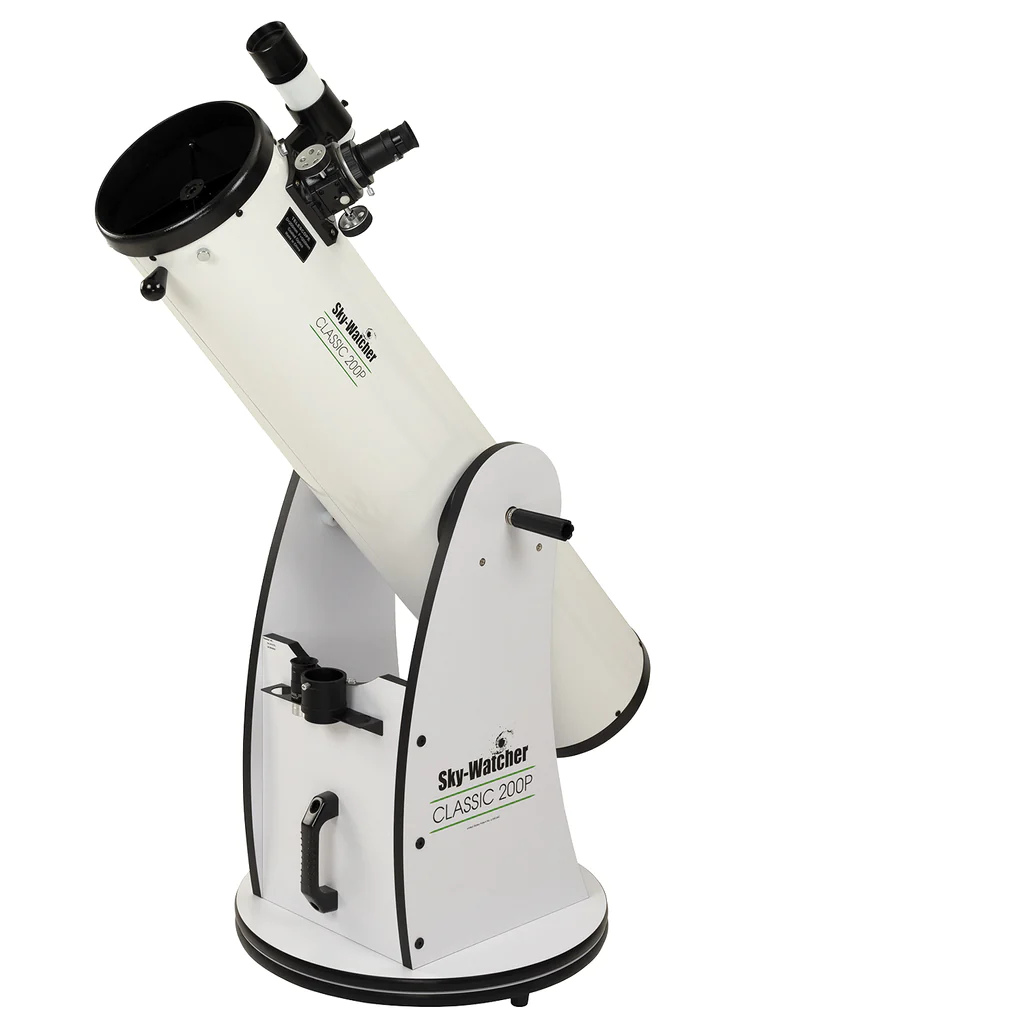
The most affordable and essential way to explore Deep Space — a large aperture Dobsonian with quality optics
Specs
| Optical design | Newtonian reflector |
| Mount type | Dobsonian |
| Aperture | 8-inch (203mm) |
| Focal length | 1200mm |
| Focal ratio | f/5.9 |
| Eyepieces included | 10mm (120x) and 25mm (48x) |
| Highest practical magnification | 406x |
| Weight | 52 lb (23.6kg) |
Pros
- Unmatched aperture-to-price ratio
- Dual 1.25-inch and 2-inch focuser
- Sturdy Mount
- 50mm optical finder
Cons
- No electronic go-to function
- It can be uncomfortable at some angles
We have discussed that a large aperture gathers significantly more light, creating a sharper and brighter image. For example, an 8-inch mirror collects 77 percent more light than a 6-inch, even if it is only 33% larger. The Sky-Watcher Skyliner 200p is a very budget-friendly telescope for profound sky observation.
It comes in nearly 48 pounds with a 54-cam footprint that can be adjusted in tight space houses. You can quickly set it and pack it away compared to other telescopes. At the same time, the Dobsonian Mount does not track or locate celestial objects. But its smooth movement makes manual tracking easy. It offers a dual-size focuser and a 2-inch eyepiece for immersive deep-sky observation. The advantage of a 2-inch eyepiece is that it provides a broader area for observation at lower magnification. If you are looking for a telescope for a deep sky, you can choose this one, or if you are on a budget, you can check others.
Celestron Advanced VX 8 Edge HD
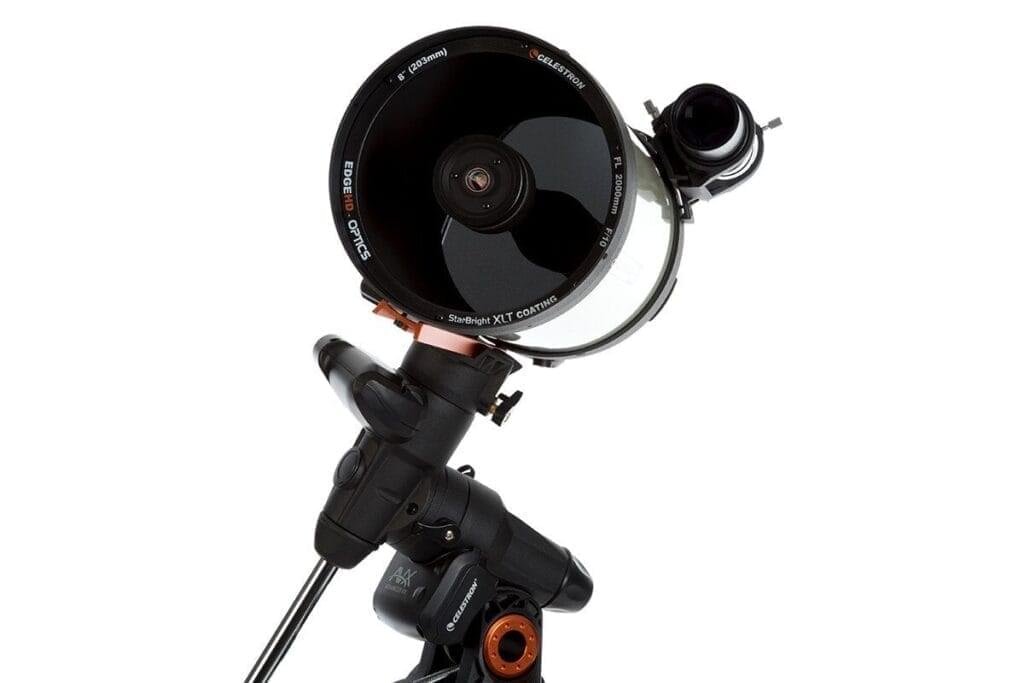
A powerful home observatory that can set itself up electronically
Specs
| Optical design | Schmidt Cassegrain compound reflector |
| Mount type | Single Fork Arm Altazimuth GoTo |
| Aperture | 8-inch (203mm) |
| Focal length | 2032mm |
| Focal ratio | f/10 |
| Eyepieces included | 12mm (150x) and 40mm (38x) |
| Highest practical magnification | 480x |
| Weight | 40.6 lb (18.4kg) |
Pros
- Super all-round compact telescope
- Completely automatic alignment with Star Sense
- Futureproof for astrophotography
- Built-in rechargeable battery
Cons
- It needs a more robust mount for serious long-exposure photography
- Expensive for its aperture
The Celestron Advanced VX Edge HD is a lightweight, small telescope for those who want to carry it to the field, with its Schmidt-Cassegrain compound reflector and 8-inch aperture. It also offers a computerized mount to point the Celestron objects. This Mount might be used with cameras, Edge HD, and other telescopes.
It comes with a 40mm eyepiece and 50x magnification. That provides clear, sharp images of star clusters, Nebulae, and other deep-space objects. We recommend buying additional 10mm and 20mm eyepieces that provide 100x and 200x views, respectively. Its polar equatorial Mount does not locate celestial objects. It could be more beginner-friendly. It would be best if you found the objects manually. You can point the point toward Polaris’s polar axis and then identify the bright star so your computer can refine and align with it. You can capture the images of beautiful galaxies and nebulae. The result will surprise you.
Sky-Watcher Flextube 16-inch 400P Synscan
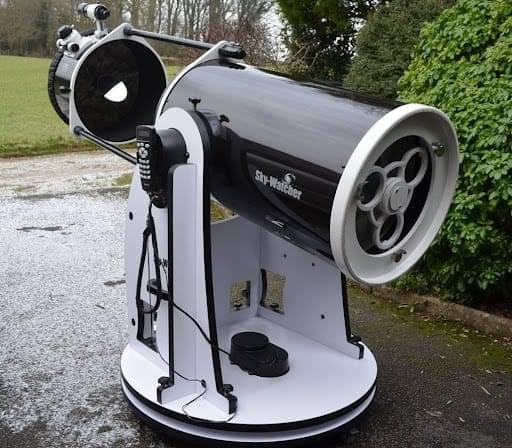
This Dobsonian gives surprising deep sky views from a giant home telescope
Specs
| Optical design | Truss tube Newtonian reflector |
| Mount type | Go-to Dobsonian |
| Aperture | 16-inch (406mm) |
| Focal length | 1800mm |
| Focal ratio | f/4.4 |
| Eyepieces included | 10mm (72x) and 25mm (180x) Plössl |
| Highest practical magnification | 799x |
| Weight | 72 lbs (32.7kg) (OTA), 105 lbs (47.6kg) (Mount) |
Pros
- Massive light grasp
- Unbeatable deep sky views
- Built-in go-to and tracking
Cons
- Very large when fully assembled
- Somewhat imprecise go-to and tracking performance
When you’re talking about observing beautiful deep space, no one can compete with the Dobsonian telescope, even if you need a step ladder to get to the eyepiece. To give users an unbeatable view of deep space. The imposing Sky-Watcher Flextube 16-inch 400P Synscan comes equipped with a 16-inch aperture. The truss tube of his telescope is cleverly designed. You can take it away because its weight is lower than another tube’s. You can cover the truss tube with a fabric shroud. Keep out unwanted light and protect the mirrors.
Vaonis Vespera Observation Station
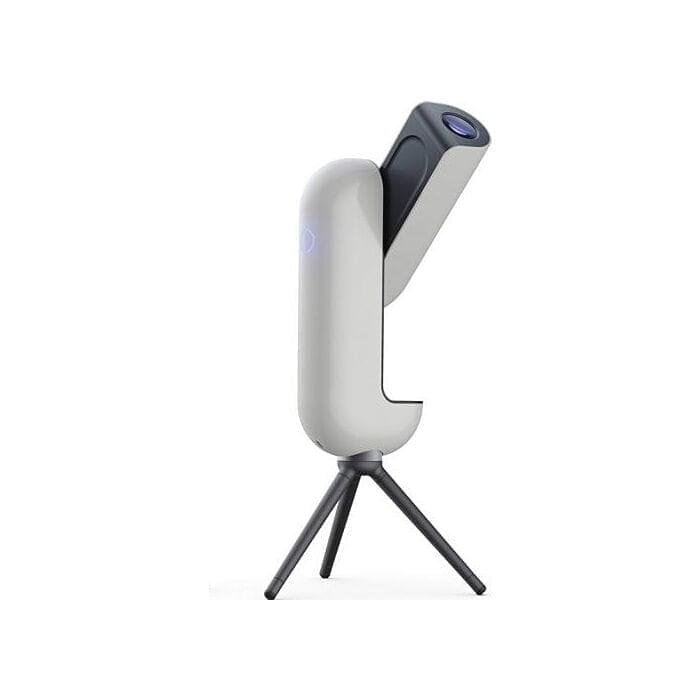
Ideal for social deep space astronomy, both beginners and non-purist veterans will love it
Specs
| Optical design | Apochromatic (APO) quadruplet refractor |
| Mount type | Motorized GoTo alt-azimuth |
| Aperture | 2-inch / 50mm |
| Focal length | 200mm |
| Focal ratio | f/4 |
| Effective magnification | 33x equiv. |
| Weight | 11 lbs (5kgs) |
Pros
- Fully automatic operation from the app
- Social deep space viewing
- Cuts through light pollution
Cons
- Images lack sharpness and resolution
- Costly (as are the accessories)
- Not a scope for traditionalists
The Vaonis Vespera Observation Station is a futuristic telescope that is the best alternative to the old traditional telescope. It is specially designed for deep-space observation. It uses a camera instead of an eyepiece. It uses live image stacking and sends it to 5 mobile phones via the singularity app. This means you can get away with a very compact white body, which weighs only 10 lbs. / 5 kg and measures 15 x 8 x 3.5 inches / 40 x 20 x 9 cm, so it’s also convenient to store away at home.
It is straightforward to use—the right choice for beginners.
The Vaonis Vespera is a perfect choice for those who live in light pollution to better experience the night sky if you buy the optional light pollution filter for an extra $199/£158.
The Vespera’s image sensor, a Sony IMX462, captures image after image and stacks them on another. Allow you to observe the process. The app tells you how many photos are charged to keep the object. It depends on objects that have been observed. The images produced by the Vespera are relatively low in resolution, with a maximum of 1920×1080 pixels.
Sky-Watcher Skymax 150
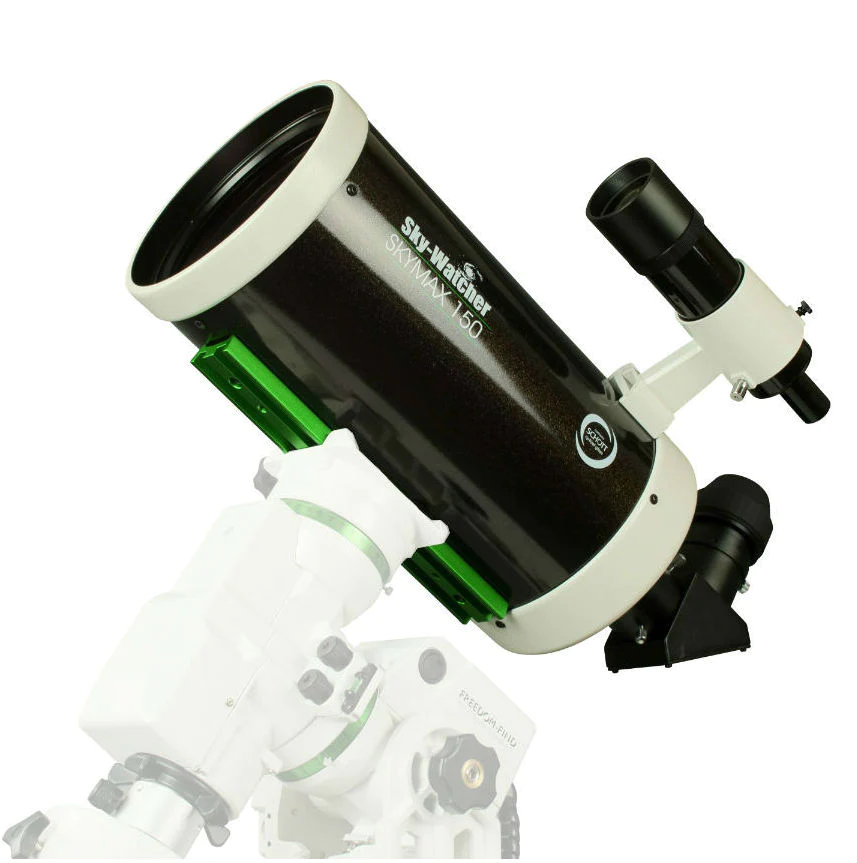
This is an all-round package for a reasonable price
Specs
| Optical design | Maksutov-Cassegrain |
| Mount type | Not included |
| Aperture | 6 in (150mm) |
| Focal length | 180mm |
| Focal ratio | f/12 |
| Eyepieces included | 2-inch 28mm eyepiece |
| Highest practical magnification | 295x |
| Weight | 12.5 lbs (5.7kgs) |
Pros
- Excellent optics
- Quality Equatorial Mount
- Suitable for long-exposure imaging
Cons
- Narrow field of view
- Heavy for some
- Not always supplied with a tripod
Sky-Watcher Skymax 150 is a versatile telescope that allows different types of observation, including planetary, lunar, and deep sky viewing. Under $1000. it provides excellent astrophotography gear. However, it is worth nothing. At the same time, sometimes the tripod is supplied, and sometimes it only depends on where your order is.
The Skymax 150 excels in optics, delivering exceptional performance without chromatic aberration or color fringing. That gives the same sharpness in images across the entire field of view. You can even get higher continuous images of your focus celestial object.
The Skymax 150 has a relatively small field of view. It is a significant drawback. While observing Nebulae stunning. It is challenging to fit it in such a small field of view. However, it allows for practical planetary observation.
Beyond the Hubble: Which Telescope is Best for Exploring Deep Space?
The Celestron NexStar 8SE telescope is an excellent choice for deep space exploration. It has an 8-inch aperture, a computerized mount, and versatility; it allows beginners and experienced astronomers to observe distant galaxies, nebulae, and star clusters. Its portability and potential for astrophotography make it a well-rounded option for stargazing. And, for those interested in capturing breathtaking astrophotographs, a compatible camera adapter unlocks exciting possibilities. Explore our Best Telescopes For Astrophotography guide to learn more about suitable setups and techniques.
Conclusion
Measure your storage space and get the most giant telescope you can! Please take advantage of our information and select cool, collapsible designs to maximize the portability. Remember that too many large telescopes will only sometimes be used. That would be very sad indeed.
Nothing is more satisfying than a night of bright stars with a large aperture telescope.
FAQs
What is the ideal aperture size for profound space observation?
The ideal aperture size depends on your observation object in space. Generally, larger apertures gather better light and faint celestial objects. So, a larger size is perfect for deep-sky observation.
Can I use these telescopes for planetary observation as well?
We can use it because most telescopes suitable for profound space observation also excel in planetary observation. Look for telescopes with versatile features.
Do I need a dark sky location for profound space observation?
While not mandatory, dark sky location enhances the visibility of faint, deep-sky objects. So, It is recommended for a more immersive experience.
Are these telescopes suitable for astrophotography?
Some of the mentioned telescopes, like the Unistellar eVscope 2, are designed for astrophotography, providing excellent image quality.
How often should I clean and maintain my telescope?
Regular maintenance is essential. Clean the optics when needed, check the Mount for stability, and store the telescope in a protective case when unused. Keep your telescope in a dry environment.



